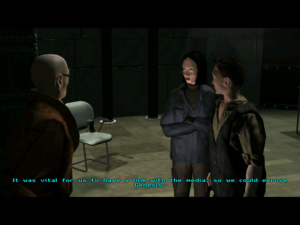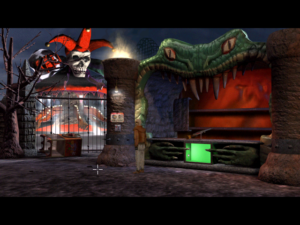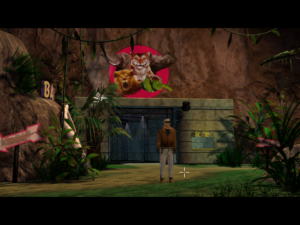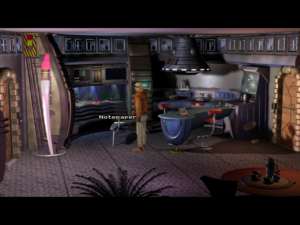Nightlong: Cheating
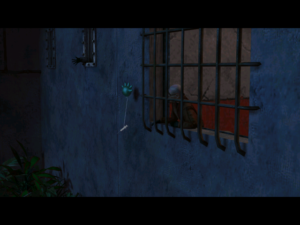 It turns out that VST is just some unspecified new cyberspace/VR technology, but one with side effects that kill people after a few months. Genesis, under the direction of Hugh Martens (your employer), is still trying to eliminate the problem, but they’re doing this by testing it illegally on prison inmates. Martens, meanwhile, has gone cartoonishly wacko about covering the whole thing up, and has been killing people left and right. If nothing else, this clinches the loyalty thing. If you completed your original assignment and brought Martens the truthmongers, he’d just kill you for knowing too much. Not that the game gives you a choice in the matter.
It turns out that VST is just some unspecified new cyberspace/VR technology, but one with side effects that kill people after a few months. Genesis, under the direction of Hugh Martens (your employer), is still trying to eliminate the problem, but they’re doing this by testing it illegally on prison inmates. Martens, meanwhile, has gone cartoonishly wacko about covering the whole thing up, and has been killing people left and right. If nothing else, this clinches the loyalty thing. If you completed your original assignment and brought Martens the truthmongers, he’d just kill you for knowing too much. Not that the game gives you a choice in the matter.
The final act of the game takes place on the prison island of Rocas Perdida, where the experiments are taking place. And it is at the very beginning of that section that I got very badly stuck. For the first and last time in the game, I resorted to a walkthrough.
This is something I really try to avoid doing. Walkthroughs are a necessary evil at best. The whole point of an adventure game is the pleasure of figuring things out, and using hints robs you of that. Worse yet, to cheat at all is to acknowledge that you’ve lost your trust in the author, that you don’t expect that you’ll be able to solve the puzzle. This lack of trust damages your experience of the rest of the game afterwards; once you’ve started down that path, it’s easy to give up on puzzles too early. I’m not even going to get into the problem of badly-written walkthroughs that give away too much, as that didn’t happen this time.
The problem, and to some extent the saving grace, of Nightlong is that I had a solid notion of what kind of unfairness I expected from it. As I’ve noted before, this is a game prone to tiny, all-but-invisible hotspots. I’d been temporarily stuck in the game many times before this point, and with only one or two exceptions, it was always due to failing to notice a hotspot. At one point, I was actually able to work backward from the expected solution to a puzzle, figuring out what sort of item I’d need, and then where I’d be likely to find it. And sure enough, it was there, and nearly unfindable unless you were looking for it specifically. This was far more satisfying than finding it by waving the cursor around at random would have been. But that was an exception. For the most part, finding something clickable in this game is a surprise. So when I got as thoroughly stuck as I was, I was fairly certain that there was a tiny hotspot that I was missing, despite repeated searching of all available rooms.
It turned out that it wasn’t a tiny hotspot. There were two hotspots with the same name close together, and I had somehow managed to avoid using the right action on the right one, despite revisiting them repeatedly. I probably should have slept on it and come back fresh, but I sometimes find it hard to convince myself of that when I know I’m nearing the end.
When I do resort to hints, my reaction is pretty much always the same, regardless of what they reveal: “That was it? What a gyp!” Even if I don’t cheat again, it can take a while for this minor sense of resentment to fade. Solving tougher puzzles later in the game helps, re-establishing the “you throw ’em at me, I’ll solve ’em” dynamic. That happened here. There was a nice convoluted unrealistic adventure-game puzzle (illustrated in the screenshot above), and the final puzzle of the game was a tasty little cryptarithm — arguably soup cans, but it hit the spot.
Anyway, it’s off the stack now.
 Comments(4)
Comments(4)